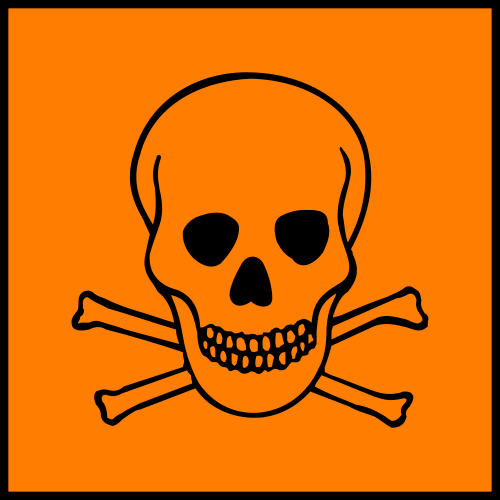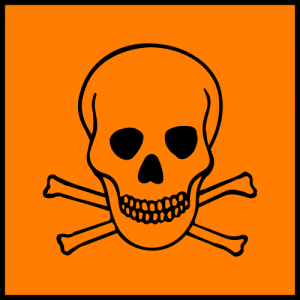
Sarin Manufacturing by Non-State Actors: A Possible Security Nightmare
Earlier this week in a post in Flashpoints Blog I argued while chemical weapons are a major national security concern, the possible manufacturing of sarin by non-state actors should be given special consideration. The manufacturing of sarin represents a unique threat because the relative ease of its synthesis and access to those chemicals needed for its synthesis; as such it is prudent to examine what treaties/regulations currently exist to hinder its manufacture and their failings.
Sarin is a binary compound that’s manufacture involves the simple mixing of two chemicals (methylphosphonyl difluoride and isopropyl alcohol). The reaction is very rapid and efficient though impurities will lead to a relatively short shelf life of weeks. Because of this, many weapons systems that deploy sarin actually mix these chemicals immediately prior to use, in some cases while in flight.
 Methylphosphonyl difluoride used in the synthesis of sarin is classified as a Schedule 1 substance under the 1993 Chemical Weapons Convention, and therefore highly regulated and restricted; internationally there is considered no valid reason for a signatory of the Convention to possess it. Methylphosphonyl difluoride is the key to sarin manufacture as other chemicals involved are too readily available to be regulated.
Methylphosphonyl difluoride used in the synthesis of sarin is classified as a Schedule 1 substance under the 1993 Chemical Weapons Convention, and therefore highly regulated and restricted; internationally there is considered no valid reason for a signatory of the Convention to possess it. Methylphosphonyl difluoride is the key to sarin manufacture as other chemicals involved are too readily available to be regulated.
Chemicals that could be used to produce sarin through a series of two or more steps, by producing methylphosphonyl difluoride as an intermediate, are covered under the Convention’s Schedule 2, though they can still be obtained within signatory states and exported.
The international community has taken steps in the past to make sure that such chemicals, even in small quantities, do not fall into the hands of rogue state actors, realizing the ease with which they could be converted to chemical weapons. However, the potential of non-state actors gaining access to relatively large quantities of these chemicals is quite real.
While there will always be the possibility of industrial chemicals being used maliciously, there is much more that the US government and the international community can do.
The current monitoring requirements under the Chemical Weapons Convention in the US for chemicals that could be used to synthesize sarin through two or more steps are surprisingly lacking. Facilities that produce or purchase such Schedule 2 chemicals are not required to report the chemicals in cases where quantities do not exceed “1 metric ton”!
Other US monitoring requirements leave much to be desired. One chemical that can be used to synthesize methylphosphonyl difluoride is monitored by the Department of Homeland Security (DHS), methylphosphonothioic dichloride, through its list of interested chemicals. However, many others are not including a much more readily convertible chemical, methylphosphonyl dichloride, which falls under Environmental Protection Agency supervision regarding the reporting of hazardous quantities in excess of 100 pounds.
Sarin’s lethality cannot be understated. One and a half grams of vaporized sarin will incapacitate and kill most individuals in a confined environment, (assumed to be 200 cubic meters), in roughly a minute. 100 pounds of methylphosphonyl dichloride, even with only a 10% synthetic yield of sarin through a two step process would produce enough sarin to carry out almost 3,200 such attacks.
Both at home and abroad, access to the precursors of methylphosphonyl difluoride should be limited and/or have their monitoring requirements greatly increased. The availability of precursor chemicals like methylphosphonic dichloride that can readily be bought on chemical web sites should be of great concern to lawmakers in the US and around the world.
American law makers or the appropriate regulatory agencies should consider greater scrutiny of chemicals like methylphosphonic dichloride that can easily be used to create chemical weapons, perhaps by considering increases to DHS’s list of chemicals of interest and changing monitoring thresholds. The international community should consider augmenting the list of precursor chemicals covered by the Chemical Weapons Convention by greatly increasing the monitoring requirements of chemicals covered under Schedule 2.
Christopher Smith is a PhD student at the University of Arizona’s Department of Chemistry and Biochemistry with a focus on Analytical Chemistry.






[…] announced that it is now certain that the Assad regime has used chemical weapons, including Sarin, “on a small scale against the opposition multiple times in the last […]